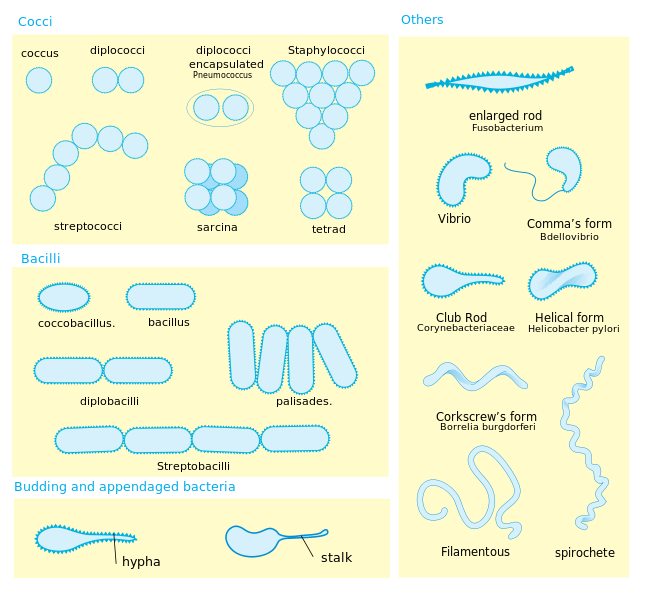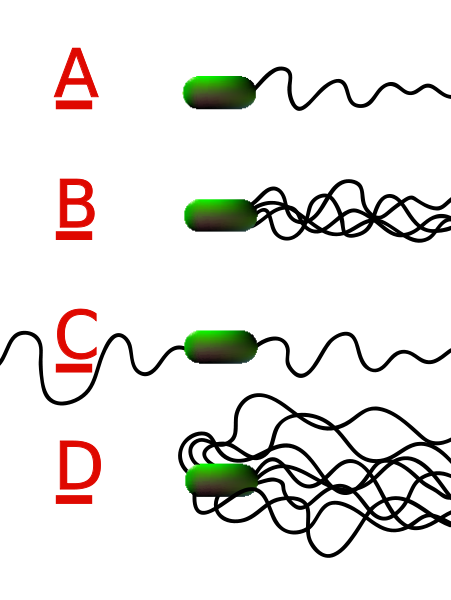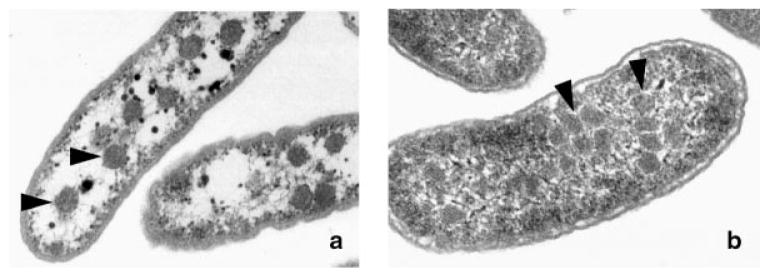Adaptations
Some of the most remarkable and fascinating qualities of Aeromonas hydrophila are its adaptations to its unpredictable
environment. For example, it is able to thrive even in polluted,
oxygen-poor environments and resist antibiotics. Because it
utilizes so many of these adaptations or resistance mechanisms,
it is sometimes referred to as the “Jack of all trades”.

· It is a
rod
shaped cell rather than a spherical cell which allows it to
maximize surface area to increase nutrient uptake. In the image
on the right, you can see that most bacteria modify their shape
in some way to increase their surface area. In this species, the
morphology most closely represents the bacillus morphology.
· It produces an
autoinducer, specifically the
second autoinducer (AI-2) which is also present in
Salmonella enterica and
E. coli. Autoinducers allow a species to communicate in
order to regulate population density. For example, it can
control antibiotic production and biofilm formation. AI-2 is
thought to be the universal signal for interspecies
communication.
· It possesses a
type II secretion system (T2SS). This is a pathway that has evolved for
the purpose of secreting extracellular proteins, one of the
major mechanisms of bacterial infection. This particular system
secretes proteases, cellulases, pectinases, phospholipases,
lipases, and toxins. These proteins are responsible for
destruction of various tissues which causes cell damage and
disease in the host. The autoinducers are involved in regulating
the secretion so that they will only be secreted when the
bacteria have reached their correct location and obtained a
critical mass, typically after it has entered the host.
· Some strains
of Aeromonas hydrophila also have a type III secretion system
(T3SS). This system secretes the extracellular components of the
flagella. Many motile plant and animal pathogens utilize a T3SS
because it allows the organism to deliver effectors, such as
toxins, to host cells. It also allows the production of complex
protein machineries that connect the bacterial cell envelope to
the eukaryotic (host) cell membrane.
· It has
developed a type VI secretion system (T6SS) which regulates
secretion for survival and fitness inside of the host
environment. For example, it regulates the degree of virulence
(its ability to infect or cause disease), the production of biofilm, and inducing cytotoxicity
in hosts. Environmental factors inside the
 host, especially pH,
trigger this T6SS.
host, especially pH,
trigger this T6SS.
· Some strains
have an additional lateral flagellar system. Many have
additional surface structures such as type IV pili and
adhesions. These
can all enhance adhesion to the eukaryotic cell surfaces, aid in
recognition of host cell receptors, and thus initiate the
colonization process. The image on the left displays the
different types of flagella that bacteria are capable of, but
Aeromonas hydrophila typically has the Type A flagella.
· It is
resistant to antibacterial factors because it is able to induce
β-lactamases and other proteins that resist lactam antibiotics
such as penicillins, cephalosporins, and several others.
·
Extracellular transducers are dominated over
intracellular signal transduction proteins. This means that the
organism expends more energy responding to their external
environment rather than their intracellular environment. Thus,
this can help the organism respond to the host environment such
as a host immune response
· It is able to
survive in highly polluted waters because it likely contains
transporters that move heavy metals or toxic compounds out of
the cell. It may also produce enzymes that alter the toxic
compounds and disinfecting chemicals to maintain environmental
stability within the cell.

· A microcompartment is specifically utilized in order to metabolize
toxic by-products away from other more sensitive cell structures.
· It secretes
acetoin which helps it maintain pH homeostasis.
· The Aeromonas
hydrophila genome contains DNA repair enzymes
since DNA damage is common in aquatic and host environments.
This mechanism is common of the gammaproteobacteria.
· It has
polysaccharide capsules which act as a protective
coating to help bacteria survive
from host immune responses such as serum killing and
desiccation, as well as phagocytes.
Most importantly, its adaptation of
enterotoxins significantly increases its
virulence once inside its host.
To return to the home page, click
here.